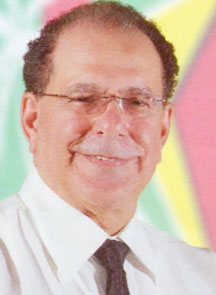Former proprietor of Vieira Communications Limited, Anthony Vieira is questioning the propriety of the Channel 28 uplink for the Guyana Learning Channel since there is supposed to be a monopoly on such services held by Guyana Telephone and Telegraph only.
Government is paying TVG, formerly Vieira Communications Limited, $3.6 million per month in a bundled package for services inclusive of the up-linking cost to the NSS-806 satellite on behalf of the Guyana Learning Channel.
In a recent letter to Stabroek News, Vieira said that at the time of the transfer of the station and all of its equipment to Queens Atlantic Investments Inc. (QAII), his station had no capacity to do uplinks and asked what the role of GT&T was in such a scenario.

“I know that in 2009 when the shares of 28 were transferred to Dr. (Ranjisinghi) Ramroop I did not have such an uplink; in fact no one except GT&T was supposed to have an uplink and the NFMU would have had to give permission to import it,” he said, asking, “When did this happen?”
He noted that GT&T would also have had to give permission “since their monopoly included all uplinks for everything ‒ telephone, television, etc.”
He asked, “Did [GT&T give permission? And if GT&T had given permission for their monopoly to be broken in this manner, since it my belief that once it is broken, it is broken, did they or the government inform Digicel?” Digicel, GT&T’s main rival here, has been lobbying for a long time for the end of the monopoly and for access to the international gateway.
Vieira noted that uplinking to a satellite is a very expensive proposition and wanted to know who would be standing the cost on behalf of the Learning Channel.
“As far as Dr Ramroop having an uplink to transmit Channel 28 by satellite all over Guyana is concerned, it might be noted that uplinking to any satellite is very expensive, and there is no income from local TV to allow it to pay for the satellite time which would receive this signal and send it back to Earth,” he said.
“This brings up a new question: if they are paying Ramroop $3.6 million per month to uplink this learning channel, who is paying the estimated US$15,000 dollars a month to rent the satellite transponder ‒ Dr. Ramroop or the Guyana taxpayers?” he asked.
Writing in a letter to Stabroek News on April 26, 2013, broadcaster Enrico Woodford said that the question with regard to the TVG/TLC arrangement is how TVG was licensed by the National Frequency Management Unit (NFMU) and when were they so licensed and for what other purpose were they licenced than TLC services?
In refuting information put out regarding uplink capabilities in Guyana, Woolford said that it is not quite accurate to say that satellite uplink and downlink facilities were not possible.
“At a price anything is available. Al Jazeera did an uplink from the Kitty foreshore within the last two years; Fox did a report from Parliament Building compound; Guyana has done the Cricket World Cup; and the Caribbean Broadcast-ing Union provided at least one of its local affiliates with the facilities to uplink,” said Woolford.
“I recall too that an entity named I-Net Communications Inc. was fully authorized to provide telecommunications services in Guyana about ten years ago. The
Guyana Government licensed I-Net to operate microwave data telecommunication equipment in the 2.4 Ghz band to provide data communication service within Guyana only,” said Woolford.
Efforts by Stabroek News to elicit comments from both GT&T and Digicel proved futile on the uplink and its implications on the monopoly.
Critics have cited the permitting of the uplink facilities for TVG as another sign of the government discriminating in favour of this entity over others. It comes on the heels of the furore over the awarding of a radio licence and multiple frequencies for its radio operations.





